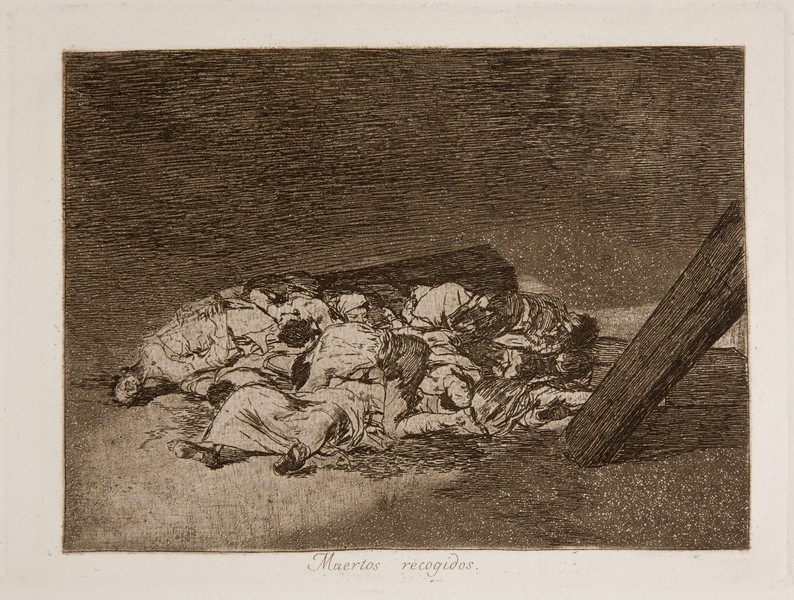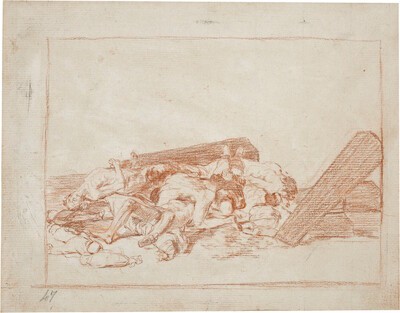- Cronología
- Ca. 1812 - 1815
- Dimensiones
- 155 x 208 mm
- Técnica y soporte
- Etching and burnished aquatint
- Reconocimiento de la autoría de Goya
- Undisputed work
- Ficha: realización/revisión
- 21 Dec 2010 / 24 May 2023
- Inventario
- 225
44 (on the lower left-hand corner of the plate).
See Sad presentiments of what must come to pass (Tristes presentimientos de lo que ha de acontecer).
The title was handwritten on the print by Goya in the first and only series that is known to have been printed at the time the works were created, which the artist gave to his friend Agustín Ceán Bermúdez. Therefore, the title was etched into the plate at a later date and left unchanged as of the first edition of the Disasters of War printed by the San Fernando Royal Academy of Fine Arts in Madrid in 1863, after the printing of the series in the possession of Ceán Bermúdez.
There is a surviving preparatory drawing for this print which is housed in the Prado Museum in Madrid.
A group of corpses lies piled up on the ground with two coffins in a dark space. The sprawling postures of the bodies, the expressions on their lifeless faces and the way in which they have been piled up evokes a strong sense of drama in this scene, in which the viewer is confronted by a jumble of corpses that have been stripped of their dignity.
The artist employs various techniques in order to highlight the pile of bodies in the centre of the composition, increasing the intensity of the dramatic atmosphere. Goya has filled the background with short, rapid, horizontal strokes in aquatint, while on the left-hand side of the print there is a lighter area worked only superficially in aquatint. This lighter area fuses with the shapes of the corpses, which are mainly dressed in white garments. The pile of bodies thus becomes a large focus of light in the print.
In this scene Goya continues to explore the theme of the previous print, no. 62, The beds of death (Las camas de la muerte), which shows several bodies covered with sheets. It is also linked with print no. 64, Cartloads for the cemetery (Carretadas al cementerio), which deals with the same subject matter. The three images reflect the insalubrious conditions in which the bodies of the dead accumulated in cities, alluding to the scarcity of resources available to provide a decent burial for the deceased. Goya produced these three pieces as the closing works in the series of prints narrating firstly the scenes of appalling violence that took place during the war and subsequently the devastating effects of famine on the population.
Therefore, this work can also be linked to others in the series depicting piles of bodies, such as no. 12 This is what you were born for (Para eso habeis nacido); no. 16, They make use of them (Se aprovechan); no. 18, Bury them and keep quiet (Enterrar y callar); no. 22, All this and more (Tanto y mas); no. 23, The same elsewhere (Lo mismo en otras partes); and no. 60, There is no one to help them (No hay quien los socorra).
The plate is stored in the National Chalcography (cat. 314).
-
Francisco de GoyaMuseo d'Arte ModernaLugano1996exhibition celebrated from September 22nd to November 17th.p.180, cat. 63
-
Francisco Goya. Sein leben im spiegel der graphik. Fuendetodos 1746-1828 Bordeaux. 1746-1996Galerie KornfeldBern1996from November 21st 1996 to January 1997cat. 147
-
Francisco Goya. Capricci, follie e disastri della guerraSan Donato Milanese2000Opere grafiche della Fondazione Antonio Mazzottacat. 143
-
Goya et la modernitéPinacothèque de ParisParís2013from October 11st 2013 to March 16th 2014cat. 102
-
2022
-
Goya, grabadorMadridBlass S.A.1918cat. 165
-
Goya engravings and lithographs, vol. I y II.OxfordBruno Cassirer1964cat. 183
-
Vie et ouvre de Francisco de GoyaParísOffice du livre1970cat. 1100
-
Catálogo de las estampas de Goya en la Biblioteca NacionalMadridMinisterio de Educación y Cultura, Biblioteca Nacional1996cat. 277
-
ParísPinacoteca de París2013p. 151
-
Goya. In the Norton Simon MuseumPasadenaNorton Simon Museum2016pp. 114-151
-
Museo de Bellas Artes de Badajoz y Diputación de Badajoz2022p. 83

